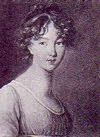This was a quick and easy project. The pattern, which is only
three sentences long, is from The New Guide to Knitting and Crochet by Marie
Jane Cooper, published by J.S. Cooper, Foreign and British Depot of Berlin
Patterns and Materials for Ladies’ Fancy Works, Royal Marine Library, Hastings
and Parry, Blenkarn & Co., London, 1847.
The suggested needles are “No. 1” and “No. 10” (modern
equivalents are 6.5mm/ US 10.5 and 3.5mm/ US 4.) The recommended wool in the
pattern is an “eight-thread fleecy;” I used Lion Brand’s Fishermen’s Wool in
Natural.
The top of each piece is ribbed with the smaller sized
needles, and the rest of the piece, on the larger sized needles, should be
“knit” which I interpreted as knitting every row resulting in a garter stitched
material. The three separate pieces, with respectively increasingly numbers of
rows, all measure 15” across and 3 ½”, 4 ½”, and 5 ½” long. To assemble, the
pattern states to “join them altogether at the part which is ribbed, and put it
on a string.” I used cotton woven
tape for the waist’s ties.
 The skirts of dresses of this
era were full, finely gathered all round the waist.* According to the The
Workwoman’s Guide** of 1838, this style of bustle was not meant to make an
unnatural curve at the rear of the body as in the latter part of the 19th
century but to be “worn by those whose shape
requires something to set off the skirt of the gown. They should not be too
large, or they look indelicate, or in bad taste.” This “Plate 11,” from the pattern
in The Workwoman’s Guide, illustrates cloth bustles (“Fig. 30, 32. “)
The skirts of dresses of this
era were full, finely gathered all round the waist.* According to the The
Workwoman’s Guide** of 1838, this style of bustle was not meant to make an
unnatural curve at the rear of the body as in the latter part of the 19th
century but to be “worn by those whose shape
requires something to set off the skirt of the gown. They should not be too
large, or they look indelicate, or in bad taste.” This “Plate 11,” from the pattern
in The Workwoman’s Guide, illustrates cloth bustles (“Fig. 30, 32. “)
A similar bustle, dated 1833 and
made of white cotton satin with linen tapes can be viewed here:
**The Workwoman's Guide by a Lady, London: Simpkin, Marshall, and Co., Stationers' Hall Court: Thomas Evans, Colmore Row, Birmingham, 1838



No comments:
Post a Comment